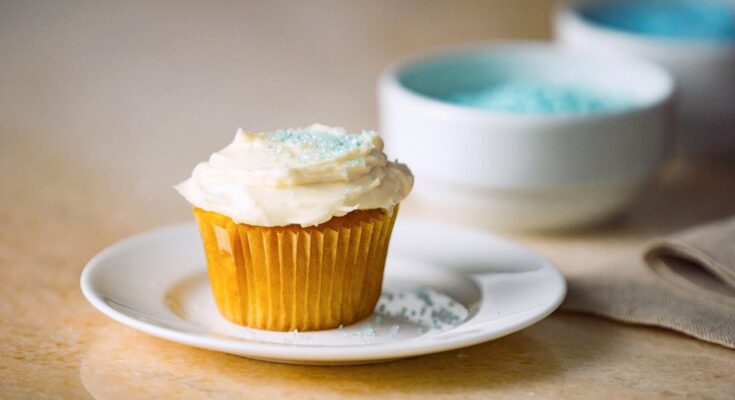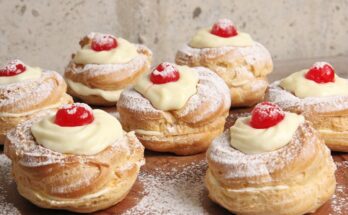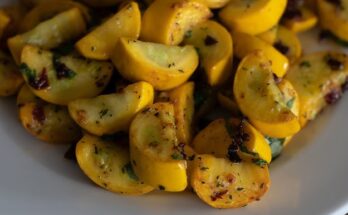American Buttercream Recipe: If you’re looking to whip up a frosting that’s rich, sweet, and ridiculously easy to make, you’re in for a treat. American buttercream is the classic go-to for cakes, cupcakes, cookies, and even as a dip for fruits (yep, some people do that!). It’s super beginner-friendly and requires just a handful of pantry staples. Whether you’re a seasoned baker or just getting started, this guide will walk you through the entire process — step by step.
What is American Buttercream?
American buttercream, often referred to simply as “buttercream,” is a frosting made primarily of butter and powdered sugar. It’s one of the most straightforward frosting recipes out there, with no eggs, no cooking, and no fuss. Unlike Swiss or Italian meringue buttercream, which require egg whites and a bit of culinary finesse, American buttercream is designed to be simple. It’s fluffy, sweet, and perfect for decorating or piping.
It’s got a dense and creamy texture that holds shape well, which makes it ideal for piping those gorgeous swirls on cupcakes or creating stunning floral decorations on cakes. While it’s not as light as whipped cream frosting or as silky as Swiss meringue, it more than makes up for it with its ease of preparation and customizable flavor.
Why It’s Popular Among Bakers
There’s a reason American buttercream is a staple in home kitchens and professional bakeries alike. Here’s why people love it:
- Quick to make – No double boilers, no thermometers.
- Customizable – Add any extract, color, or spice.
- Stable at room temperature – It holds up well for hours.
- Perfect for piping – Holds shapes beautifully with minimal effort.
- Kid-approved sweetness – Its sugary punch is often a favorite with kids and sweet tooth lovers.
Whether you’re frosting a birthday cake, making cookies for a holiday event, or prepping cupcakes for a school bake sale, American buttercream is always a reliable choice.
Ingredients Needed
Basic Ingredients
You only need a few ingredients to whip up a batch of American buttercream. The best part? You probably already have them in your kitchen.
- Unsalted Butter – 1 cup (2 sticks), softened to room temperature
- Powdered Sugar (Confectioners’ Sugar) – 4 cups, sifted
- Heavy Cream or Milk – 2 to 4 tablespoons (for thinning)
- Vanilla Extract – 1 to 2 teaspoons
- Salt – A pinch (optional, but balances the sweetness)
These five ingredients are the foundation. The butter adds richness, the sugar sweetens and stiffens, and the milk or cream helps you control the consistency. Vanilla ties it all together, giving that classic bakery flavor.
Optional Flavorings and Variations
Here’s where the fun begins. You can totally customize your buttercream with these additions:
- Almond Extract – Just ¼ teaspoon adds a nutty twist.
- Lemon or Orange Zest – Perfect for summer cakes.
- Cocoa Powder – Make it a chocolate buttercream.
- Espresso Powder – Adds a coffee kick.
- Food Coloring – Gel-based colors are best for vivid hues.
By mixing and matching these flavor enhancers, you can take your basic buttercream to a gourmet level in just seconds.
Tools and Equipment You’ll Need
Essential Baking Tools
Let’s make life easier by having the right gear on hand. You don’t need anything fancy, but having these essentials makes the process smoother:
- Electric Mixer – Stand mixer with a paddle attachment or a hand mixer
- Mixing Bowl – Preferably stainless steel or glass
- Spatula – For scraping down the bowl
- Measuring Cups and Spoons – Accuracy is key
- Sifter – Optional, but it prevents lumpy sugar
The electric mixer is the MVP here. Sure, you could mix by hand, but your arms won’t thank you.
Optional Tools to Make Things Easier
- Piping Bags and Tips – For decorating cupcakes or cakes
- Bench Scraper – For smoothing sides of a cake
- Offset Spatula – Great for spreading the buttercream evenly
- Turntable – Makes decorating cakes a breeze
These aren’t must-haves, but if you’re planning to level up your cake decorating game, they’re worth investing in.
Step-by-Step Instructions
Time to get to the heart of it! Let’s break this recipe down into easy steps. Grab your apron — things are about to get sweet.
Step 1: Preparing Your Ingredients
Start with butter at room temperature — not melted, not cold. Room temp butter should be soft enough to leave an indent when you press it, but not so soft it’s melting.
Sift your powdered sugar. It might feel like a chore, but it’s a small step that makes a big difference. No one likes biting into a chunk of sugar in their frosting.
Measure out your milk or cream and extract so they’re ready to go when you need them.
Step 2: Creaming the Butter
Add your softened butter to the mixing bowl. Beat it on medium-high speed for about 2–3 minutes until it becomes pale and fluffy.
This step is essential. Creaming incorporates air into the butter, giving your frosting a light texture. Don’t rush it — let that mixer do its thing.
You’re looking for a silky, smooth butter base before any sugar goes in. Scrape down the sides of the bowl halfway through to make sure everything’s getting evenly whipped.
Step 3: Adding Powdered Sugar
Add the powdered sugar one cup at a time, mixing on low speed at first (unless you want a powdered sugar explosion all over your kitchen).
Step 4: Adjusting Consistency
This is where the buttercream really starts to come together. At this point, your frosting might be a bit thick and stiff — perfect if you’re piping roses or intricate decorations, but too much if you’re spreading it on a cake.
To adjust the consistency, add milk or cream one tablespoon at a time. Start with 2 tablespoons and beat well after each addition. Keep adding until you get your desired texture.
- For piping, you’ll want it stiffer, so don’t overdo the liquid.
- For frosting a cake, go for a softer, spreadable texture.
If, by accident, you add too much liquid and it gets too runny, don’t panic! Just add more sifted powdered sugar a tablespoon at a time until it thickens back up.
This part is all about feel. The more you practice, the better you’ll get at knowing the perfect texture just by looking at it.
Step 5: Adding Flavorings and Colors
Once your butter and sugar are happily whipped together, it’s time to jazz things up. Add vanilla extract and mix until fully incorporated. Want more personality? Here’s where you can introduce different extracts or zests.
For colored frosting, add gel food coloring at this stage. Gel colors are highly concentrated and won’t water down your frosting like liquid dyes. Add just a tiny bit on the tip of a toothpick, mix, and assess the color. You can always add more, but you can’t take it out!
Divide the frosting into bowls if you’re doing multiple colors. Mix thoroughly until the color is even throughout.
This step turns your frosting from basic to beautiful. Whether you’re going for pastel Easter hues, bold birthday shades, or deep holiday tones, this is where you shine.
Tips for Perfect American Buttercream
How to Fix Common Issues
Even though American buttercream is forgiving, here are a few common hiccups and how to fix them:
- Too Sweet? Add a pinch of salt or a bit of lemon juice to cut the sweetness.
- Too Thick? Add a splash of cream or milk to loosen it up.
- Too Thin? Add a little more powdered sugar to firm it back up.
- Grainy Texture? Your sugar may not have been sifted, or your butter was too cold. Beat it longer — that usually helps smooth it out.
The key is to not panic. Buttercream is versatile. Most issues can be fixed with a little patience and the right tweaks.
Best Practices for Smooth, Creamy Results
Want that bakery-style finish? Follow these pro tips:
- Use unsalted butter – This gives you control over the saltiness.
- Beat your butter first – Don’t add sugar until the butter is fluffy.
- Sift your sugar – Always. Lumpy frosting is never fun.
- Don’t skimp on mixing – The more you whip, the fluffier the frosting.
- Use cream instead of milk – It gives a richer, smoother texture.
Here’s a bonus: buttercream can be made in advance and stored in the fridge for up to a week or frozen for up to 3 months. Just let it come to room temp and re-whip before using.
You now have a fail-proof formula and pro tips that can turn even a basic cake into something spectacular. Whether you’re baking for a celebration or just because it’s Tuesday and you want cake, this buttercream is the finishing touch that’ll wow every time.
Flavor Variations to Try
Chocolate American Buttercream
For all the chocolate lovers out there, turning your standard buttercream into a chocolate delight is super easy. Simply add ¾ cup of unsweetened cocoa powder or melted and cooled semi-sweet chocolate (about 4 oz) to the basic recipe.
Here’s how:
- After you cream the butter and sugar, mix in the cocoa powder or melted chocolate.
- Add a pinch of salt and a splash more cream if needed — cocoa can dry things out a bit.
- Mix on medium-high until smooth, fluffy, and fully blended.
This chocolate version is rich, fudgy, and perfect on chocolate or vanilla cupcakes. Pro tip: add a little espresso powder to deepen the chocolate flavor even more.
Lemon Buttercream
Craving something zesty and fresh? Swap out the vanilla extract for 1–2 teaspoons of lemon extract and add 1 tablespoon of lemon zest. A small splash of fresh lemon juice will boost the tartness, but go easy — too much liquid can mess with the texture.
Lemon buttercream is light, refreshing, and pairs beautifully with blueberry cakes, vanilla sponge, or even lavender cupcakes.
Strawberry Buttercream
For fruity goodness, blend freeze-dried strawberries into a powder and add about ½ cup to the buttercream. Alternatively, you can reduce strawberry puree into a thick concentrate (important — no excess water!) and mix it in. This gives you that authentic berry taste without artificial flavorings.
This variation not only adds flavor but also a beautiful natural pink color — no food dye needed.
Salted Caramel Buttercream
Swirl in ¼ to ½ cup of homemade or store-bought caramel sauce for a sweet, salty kick. It’s insanely good on chocolate cake, banana cupcakes, or apple-spice treats. Just make sure your caramel is cooled and thickened so it doesn’t water down the buttercream.
Storage and Make-Ahead Tips
One of the best things about American buttercream is how well it stores. You can make it ahead of time and still have it taste freshly whipped when you’re ready to use it.
Room Temperature
If you’re using the buttercream within a day, it’s fine to keep it covered at room temperature for up to 24 hours — especially in cooler weather. Just give it a quick re-whip before using to bring back that fluffy texture.
Refrigerator
Need to store it longer? Pop it in an airtight container and refrigerate for up to 7 days. When you’re ready to use it:
- Let it sit out until it comes to room temperature (this may take a few hours).
- Re-whip with your mixer to restore its creamy consistency.
Freezer
For long-term storage, buttercream freezes beautifully. Place it in a freezer-safe container or zip-lock bag, remove as much air as possible, and freeze for up to 3 months.
To thaw:
- Move it to the fridge overnight.
- Let it come to room temperature the next day.
- Whip it again before using.
Whether you’re batch baking for an event or just like being prepared, these storage options are lifesavers.
Creative Ways to Use American Buttercream
Buttercream isn’t just for cakes. Let’s get creative! Here are some fun and unexpected ways to use your frosting masterpiece:
1. Cookie Sandwiches
Spread a thick layer between two cookies for the ultimate homemade treat. Sugar cookies, chocolate chip, oatmeal — they all work.
2. Dessert Dips
Yes, really. Serve your flavored buttercream in a bowl with fruit slices, pretzels, or graham crackers. It’s like dessert fondue.
3. Pancake or Waffle Topping
Want to make brunch extra special? Add a dollop of flavored buttercream on warm pancakes or waffles instead of syrup.
4. Filling for Macarons
Macaron lovers know that buttercream makes a rich, reliable filling. Match the flavor to your macaron shell or contrast for something bold.
5. Layering in Parfaits or Trifles
Layer spoonfuls of buttercream with cake cubes and fruit in a glass for a no-bake dessert that looks as good as it tastes.
FAQs about American Buttercream Recipe
Q1: What is American buttercream made of?
American buttercream is made with just a few simple ingredients—butter, powdered sugar, vanilla extract, and a splash of milk or cream. It’s sweet, fluffy, and easy to whip up in minutes.
Q2: Can I make American buttercream without a mixer?
Yes, you can! While a mixer makes the job easier and fluffier, you can mix it by hand using a sturdy whisk or spatula—it’ll just take a bit more elbow grease.
Q3: Why is my buttercream too sweet?
American buttercream is known for its sweetness. To cut the sweetness, try adding a pinch of salt, a splash of lemon juice, or even a bit of unsweetened cocoa powder for balance.
Q4: How do I fix runny buttercream?
If your buttercream is too runny, chill it in the fridge for 15–20 minutes. You can also add more powdered sugar, a tablespoon at a time, until it thickens to your liking.
Q5: Can I make American buttercream ahead of time?
Absolutely! Store it in an airtight container in the fridge for up to 1 week or freeze it for up to 3 months. Just bring it to room temperature and re-whip before using.
Q6: Is American buttercream good for hot weather?
Not really. It’s butter-based, so it can melt or soften quickly in warm conditions. For hot climates, consider using a Swiss meringue or shortening-based frosting instead.
Conclusion
American buttercream is the jack-of-all-trades in the world of frostings. It’s sweet, rich, easy to make, and endlessly adaptable. With just a few simple ingredients and a little practice, you can whip up bakery-worthy frosting in under 10 minutes.
Whether you keep it classic with vanilla or branch out into fun flavors like strawberry or salted caramel, buttercream lets your creativity shine. Plus, it stores like a dream, making it perfect for weekend bakers and pros alike.
So next time you’re staring down a plain cake or a batch of cupcakes, you know exactly what to do — grab your butter and sugar and make some magic.



